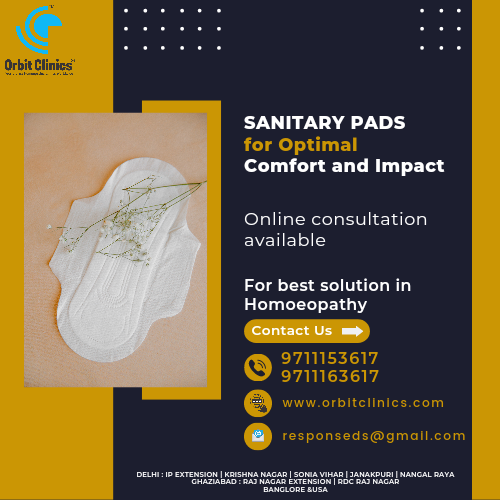“Unravel the Pros, Cons, and Selection Criteria for Sanitary Pads – Your Comprehensive Guide to Confident Period Management”

Written by
Dr. Deepak Sharma
BHMS, MD, Ph.D. (Scholar)
Homeopathic Physician and Educator
Founder – Orbit Clinics
Introduction:
Sanitary pads, also known as menstrual pads or sanitary napkins, are absorbent products used by women during menstruation. They are designed to be worn in underwear and are intended to absorb the menstrual flow to keep women comfortable, clean, and protected during their period. In this article, we will discuss the pros and cons of using sanitary pads during menstruation, allowing users to make an informed choice.
Advantages of Sanitary Pads:
- Easy to use: Sanitary pads are easy to use and generally come with adhesive strips that can be stuck to the underwear. They can be quickly changed, making them convenient for women on the go.
- Variety of options: Sanitary pads are available in a wide range of sizes, absorbency levels, and materials, catering to different preferences and needs. Women can choose from ultra-thin, regular, or maxi pads with wings or without, allowing for a customized and comfortable experience.
- No internal insertion: Unlike tampons or menstrual cups, sanitary pads do not require internal insertion. This can be particularly beneficial for women who are not comfortable with inserting products into their vagina or for those with certain health conditions.
- Suitable for all ages: Sanitary pads can be used by girls who have just started menstruating as well as adult women. They are a reliable and accessible option for all age groups.
Disadvantages of Sanitary Pads:
- Environmental impact: Traditional disposable sanitary pads are made from plastic and other non-biodegradable materials. This means that they can take hundreds of years to decompose, contributing to environmental pollution and waste. However, there are eco-friendly alternatives such as reusable cloth pads or biodegradable pads that can help mitigate this issue.
- Skin irritation and allergies: Some women may experience skin irritation or allergies due to the synthetic materials, fragrances, or chemicals used in the manufacturing of sanitary pads. In such cases, it is important to switch to hypoallergenic or organic options.
- Bulkiness and discomfort: Some women may find certain types of sanitary pads bulky and uncomfortable, especially during physical activities or while wearing tight clothing. However, the variety of options available allows women to choose a pad that suits their comfort level.
- Cost: Regular use of disposable sanitary pads can be expensive in the long run. Reusable alternatives like cloth pads or menstrual cups can be more cost-effective and environmentally friendly.
How does a female choose a good sanitary pad for her menstrual cycle?
Choosing a good sanitary pad for one’s menstrual cycle depends on personal preferences and individual needs. Here are some factors to consider when selecting a sanitary pad:
- Absorbency: Choose a pad that can handle the flow of your period. Light, regular, heavy, or super-heavy are common absorbency levels. You may need to use different absorbency pads throughout your menstrual cycle.
- Length and size: Pads come in various lengths and sizes, such as regular, long, or extra-long. Longer pads provide more coverage and are ideal for heavy flow or nighttime use. Consider your comfort and the level of protection you need when choosing the size.
- Material: Look for pads made from materials that suit your skin type and personal preferences. Options include cotton, organic cotton, and synthetic materials. Some individuals prefer organic or hypoallergenic pads to reduce the risk of irritation or allergies.
- Wings or no wings: Wings are side flaps that wrap around the sides of your underwear to help prevent leaks. If you’re prone to leakage or prefer extra protection, consider pads with wings.
- Thickness: Pads can be thick and fluffy or thin and discreet. Choose the thickness that feels most comfortable for you and provides the protection you need.
- Adhesive: Ensure that the pad has a strong adhesive to keep it in place and prevent it from shifting during use.
- Scented or unscented: Scented pads contain fragrance, which may help mask odors. However, they can also cause irritation or allergic reactions in some individuals. Unscented pads are a safer option if you have sensitive skin or allergies.
- Packaging: Look for pads that come in discreet, easy-to-open packaging if privacy is a concern.
- Brand reputation: Research and consider brands that have good reputations for quality and customer satisfaction. You can read reviews or ask friends for recommendations.
- Price: Sanitary pads can vary in price. While it’s important to stay within your budget, don’t sacrifice quality for the sake of cost. It’s essential to invest in pads that provide the comfort and protection you need.
Conclusion:
Sanitary pads can be both good and bad for females during menstruation, depending on individual preferences, needs, and circumstances. They provide a convenient and accessible option for menstrual hygiene, but it is essential to consider the environmental impact and personal comfort when choosing the right product. By exploring the different types of sanitary pads available and making informed choices, women can find a suitable and comfortable solution for managing their periods.
References:
- Beksinska, M. E., Smit, J., & Greener, R. (2013). Menstrual hygiene in South African girls: Use of sanitary products. South African Journal of Child Health, 7(4), 127-131.
- Garg, R., Goyal, S., & Gupta, S. (2012). India moves towards menstrual hygiene: Subsidized sanitary napkins for rural adolescent girls—Issues and challenges. Maternal and Child Health Journal, 16(4), 767-774.
- Hennegan, J., Dolan, C., Wu, M., Scott, L., & Montgomery, P. (2016). Measuring the prevalence and impact of poor menstrual hygiene management: A quantitative survey of schoolgirls in rural Uganda. BMJ Open, 6(12), e012596.
- Kaur, R., Kaur, K., & Kaur, R. (2018). Menstrual hygiene, management, and waste disposal: Practices and challenges faced by girls/women of developing countries. Journal of Environmental and Public Health, 2018, 1730964.
- North, B. B., & Oldham, M. J. (2011). Preclinical, clinical, and over-the-counter postmarketing experience with a new vaginal cup: Menstrual collection. Journal of Women’s Health, 20(2), 303-311.
- Oster, E., & Thornton, R. (2011). Menstruation, sanitary products, and school attendance: Evidence from a randomized evaluation. American Economic Journal: Applied Economics, 3(1), 91-100.
- Sommer, M., & Sahin, M. (2013). Overcoming the taboo: Advancing the global agenda for menstrual hygiene management for schoolgirls. American Journal of Public Health, 103(9), 1556-1559.
- Torondel, B., Sinha, S., Mohanty, J. R., Swain, T., Sahoo, P., Panda, B., & Das, P. (2018). Association between unhygienic menstrual management practices and prevalence of lower reproductive tract infections: A hospital-based cross-sectional study in Odisha, India. BMC Infectious Diseases, 18(1), 473.
- van Eijk, A. M., Sivakami, M., Thakkar, M. B., Bauman, A., Laserson, K. F., Coates, S., & Phillips-Howard, P. A. (2016). Menstrual hygiene management among adolescent girls in India: A systematic review and meta-analysis. BMJ Open, 6(3), e010290.
- World Health Organization. (2018). Menstrual health and hygiene. Retrieved from https://www.who.int/news-room/fact-sheets/detail/menstrual-health-and-hygiene
Founder – Orbit Clinics




